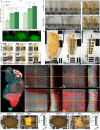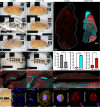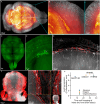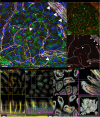ADAPT-3D:accelerated deep adaptable processing of tissue for 3-dimensional fluorescence tissue imaging for research and clinical settings
- PMID: 40883418
- PMCID: PMC12397274
- DOI: 10.1038/s41598-025-16766-z
ADAPT-3D:accelerated deep adaptable processing of tissue for 3-dimensional fluorescence tissue imaging for research and clinical settings
Erratum in
-
Correction: ADAPT-3D:accelerated deep adaptable processing of tissue for 3-dimensional fluorescence tissue imaging for research and clinical settings.Sci Rep. 2025 Sep 22;15(1):32625. doi: 10.1038/s41598-025-19773-2. Sci Rep. 2025. PMID: 40983607 Free PMC article. No abstract available.
Abstract
Light sheet microscopy and preparative clearing methods that improve light penetration in 3D tissues have revolutionized imaging in biomedical research. Here we present ADAPT-3D, a streamlined 3-step approach to turn tissues optically transparent while preserving tissue architecture with the versatility to handle diverse tissue sizes and types across species. Unlike extensive lipid removal utilized by existing protocols, ADAPT-3D only partially removes lipids to preserve cell membranes, yet the non-toxic aqueous refractive indexing solution still rapidly turns tissues transparent while preserving the fluorescence of endogenous and antibody conjugated fluorophores. ADAPT-3D prepares whole mouse brains for light sheet microscopy in a 4-hour refractive indexing step after less than 4 days of preprocessing without changing their size. By maintaining tissue size, ADAPT-3D clears 1-mm thick brain slices in under 24 h without causing damage and facilitates a 3D section-like view of the meandering choroid plexus. We applied ADAPT-3D to overcome challenges of whole mouse skull clearing and visualized the undisturbed brain borders including specialized skull channels after just 8 days of tissue preparation. ADAPT-3D also had utility in clearing and immunolabeling human intestinal tissues in about 5 days. Overall, ADAPT-3D provides a high-speed, non-shrinking, and fluorescence-preserving workflow for 3D imaging that bridges section-based and whole-organ studies, offering new opportunities for biological discovery.
© 2025. The Author(s).
Conflict of interest statement
Declarations. Competing interests: Washington University and D.D.L., D.L.D., R.S.C., B.H.Z., and G.J.R. have filed a provisional patent on ADAPT-3D. ADAPT-3D solutions are being commercially developed by Leinco Technologies, Inc., Saint Louis, Missouri ( https://www.leinco.com ). J. K. is cofounder of Rho Bio that aims to develop therapeutics for the lymphatic vasculature. Other authors declare no competing interests.
Figures




Update of
-
ADAPT-3D: Accelerated Deep Adaptable Processing of Tissue for 3-Dimensional Fluorescence Tissue Imaging for Research and Clinical Settings.Res Sq [Preprint]. 2025 Mar 24:rs.3.rs-6109657. doi: 10.21203/rs.3.rs-6109657/v1. Res Sq. 2025. Update in: Sci Rep. 2025 Aug 29;15(1):31841. doi: 10.1038/s41598-025-16766-z. PMID: 40195996 Free PMC article. Updated. Preprint.
References
-
- Chung, K. & Deisseroth, K. CLARITY for mapping the nervous system. Nat. Methods. 10, 508–513 (2013). - PubMed
MeSH terms
Grants and funding
LinkOut - more resources
Full Text Sources
Molecular Biology Databases

